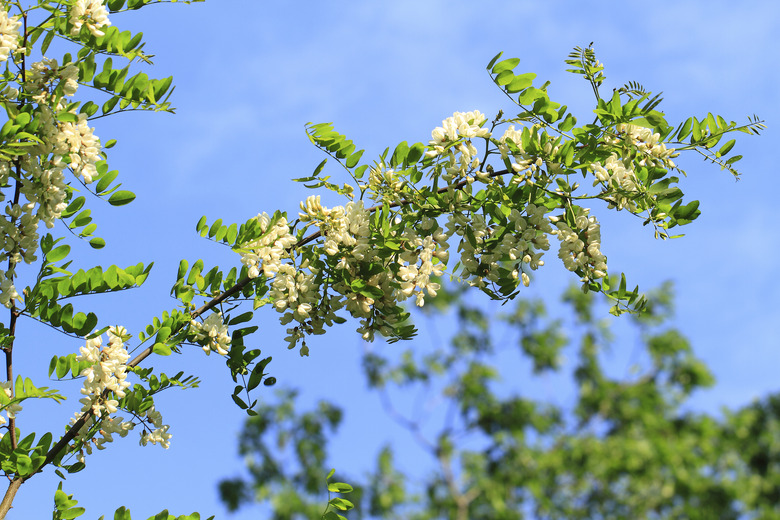What Are The Dangers Of Black Locust Tree Thorns?
The black locust tree (Robinia pseudoacacia), also called false acacia, grows in U.S. Department of Agriculture plant hardiness zones 3 to 8. In addition to its usefulness as a shade tree, black locust features attractive springtime blossoms and a pleasant fragrance. The thorns that grow in pairs below the leaves serve as protection for the tree, but can be potentially dangerous in your yard.
Toxic Tree
All parts of a black locust are extremely toxic and can cause severe stomach pain or death in children, pets and livestock if eaten. This is especially problematic with livestock — particularly cows and horses — which often graze on tree leaves. The thorns grow on branches at the base of a cluster of leaves, so it would be easy for an animal to eat the thorns while also taking a bite of leaves. The leaves are also toxic, but in addition to thorn toxicity is the problem of extreme pain when swallowing thorns that grow up to 2 inches long. Keep livestock well away from black locust. If you want to attract grazing deer or other animals to your yard, don't plant black locust.
- The black locust tree (Robinia pseudoacacia), also called false acacia, grows in U.S. Department of Agriculture plant hardiness zones 3 to 8.
- The thorns that grow in pairs below the leaves serve as protection for the tree, but can be potentially dangerous in your yard.
Walkway Hazard
A black locust planted too close to a walkway or high-traffic area of your yard could easily scratch or poke at passersby. Although being scratched by the tree isn't poisonous, because it's only toxic if eaten, those sharp barbs can certainly hurt. A young child at eye level to a black locust tree canopy could get poked in the eye. The thorns don't grow along the trunk, so this is mostly problematic with young trees. Beware fallen branches, because the thorns can easily poke through a thin shoe sole.
Inflatable and Plastic Equipment
Inflatable toys, pools, plastic water slides, bounce houses and other equipment keep kids busy outdoors, but black locust thorns can bring the fun to an abrupt end. Branches can fall out of the trees on windy days and easily tear holes in the thin, plastic material used to make these items. Even pools and ponds with rubber liners can be punctured if a locust branch with thorns falls in the water. Puncture holes can also happen if you place the equipment in the yard without first checking for fallen thorny branches. Anchor inflatable equipment to the ground so it doesn't get caught in the wind and blown into a small black locust tree, where it can snag on the sharp thorns.
- A black locust planted too close to a walkway or high-traffic area of your yard could easily scratch or poke at passersby.
- Inflatable toys, pools, plastic water slides, bounce houses and other equipment keep kids busy outdoors, but black locust thorns can bring the fun to an abrupt end.
Wildlife Habitat
Birds often rely on thorny bushes and trees to provide protected shelter. While you might welcome some new avian residents to your garden, black locust trees might also invite nuisance birds such as crows. Crows scare away other birds and can also devour a vegetable garden well before you have a chance to harvest. If you want to keep black locusts on your property while discouraging bird pests, cover crops with bird netting. Alternatively, install lots of birdhouses to invite a martin bird colony to your yard — these birds won't destroy your garden and help keep crows away.
